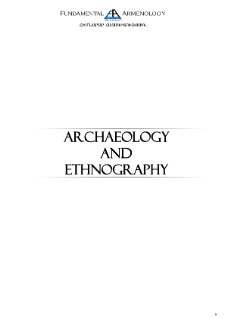Նիւթ
Վերնագիր: The Caucasioni Component Of Individuals From Hovhannavank Monument
Հրապարակման մանրամասներ:
Ամսագրի կամ հրապարակման վերնագիր:
Հիմնարար հայագիտություն=Fundamental Armenology
Հրապարակման ամսաթիւ:
Համար:
ISSN:
Պաշտոնական URL:
Աջակից(ներ):
Ամփոփում:
The population of medieval Armenia was not homogeneous. Some combinations of craniological features of South-European race are extant. According to the craniological data on our disposal today, among the late medieval population of Hovhannavank are present specific complexes of features not characteristic for the Armenian population of later periods. This complex of features stands close to the Caucasioni type. Closest analogues to that type were found among the population of Georgia, Azerbaijan (Mingechaur) and Iran (Turang Tepe). Basing on anthropological and paleopathological data, two types of deformation were observed: circular high (high ring) and low. Pathological changes represent a certain adaptation form to ecobiological and social environmental factors. The leading among the unfavorable environmental factors is general infectious background.
Հրատարակիչ:
Ձեւաչափ:
Չափեր:
Ֆիզիկական այլ նկարագրութիւն:
Նոյնացուցիչ:
oai:arar.sci.am:265183
Լեզու:
Նիւթին հաւաքածոները:
Վերջին անգամ ձեւափոխուած է:
Dec 13, 2023
Մեր գրադարանին մէջ է սկսեալ:
Jan 18, 2021
Նիւթին բովանդակութեան հարուածներուն քանակը:
73
Նիւթին բոլոր հասանելի տարբերակները:
https://arar.sci.am/publication/288831
Ցոյց տուր նկարագրութիւնը RDF ձեւաչափով:
Ցոյց տուր նկարագրութիւնը OAI-PMH ձեւաչափով։
-
Հիմնարար հայագիտություն=Fundamental Armenology
-
Հիմնարար հայագիտություն, 2015, հատոր 1
-
Հիմնարար հայագիտություն, 2015, հատոր 2
-
Հիմնարար հայագիտություն, 2016, հատոր 1 (3)
-
Հիմնարար հայագիտություն, 2016, հատոր 2 (4)
-
Հիմնարար հայագիտություն, 2017, հատոր 1 (5)
-
Հիմնարար հայագիտություն, 2017, հատոր 2 (6)
-
Հիմնարար հայագիտություն, 2018, հատոր 1 (7)
-
Հիմնարար հայագիտություն, 2018, հատոր 2 (8)
-
Հիմնարար հայագիտություն, 2019, հատոր 1 (9)
-
Հիմնարար հայագիտություն, 2019, հատոր 2 (10)
-
Հիմնարար հայագիտություն, 2020, հատոր 1 (11)
-
Հիմնարար հայագիտություն, 2020, հատոր 2 (12)
- Editorial Board
- Contents
- Academics Call On Global Institutions To Save Armenian Heritage Before It's Too Late
- The Caucasioni Component Of Individuals From Hovhannavank Monument
- The Armenian Genocide And The Heroic Self-Defensive Battles Of The Cilician Armenians
- Grigor Janshyan's Help To The Western Armenians During The Hamidian Massacres
- An Episode From The History Of The Armenian Church
- Adoption Of The Program-Declaration Of Transcaucasian Seim And Its Legislative Activities (February–March)
- Azerbaijan: The History Of A Disease Or External Factors Of The Formation Of Genocidal Political Culture Of Transcaucasian Turks
- The Earth and its inhabitants. The Universal Geography. Edited by A.H. Keane, B.A. member of council, Anthropological Institute. Vol. VI. Asiatic Russia, London, J.S. Virtue and Co., Limited, 294, City Road, pp. 130-149.
- Earth and its Inhabitants. Asia Edited by A.H. Keane, B.A., Vol. IV. South-Western Asia. New York: 1891. pp. 162-191. Asiatic Turkey.
- The Documents Regarding The Atrocities Of The Armenian Population Of The Vilayet Of Mamouret-Ul-Aziz In 1915 Extracted From “The Treatment Of Armenians In The Ottoman Empire (1915-16)”
- Harutyun Martirosyan: The Citadel Of The City Of Teishebaini And Cultural Relations With Local Tribes
- Johann Heinrich Hübschmann (1848- 1908)
- Gagik Sargsyan (1926-1998)
- Henrik Abrahamyan, Social And Political Prerequisites For The Declaration Of Independence Of The Republic Of Armenia And The Beginning Of Its Formation (February 1956 – September 1991). – Yerevan, 2020.
- New books
-
Հիմնարար հայագիտություն, 2021, հատոր 1 (13)
-
Հիմնարար հայագիտություն, 2021, հատոր 2 (14)
-
Հիմնարար հայագիտություն, 2022, հատոր 1 (15)
-
Հիմնարար հայագիտություն, 2022, հատոր 2 (16)
-
Հիմնարար հայագիտություն, 2023, հատոր 1 (17)
-
Հիմնարար հայագիտություն, 2023, հատոր 2 (18)
-
Հիմնարար հայագիտություն, 2024, հատոր 1 (19)
-
Հիմնարար հայագիտություն, 2024, հատոր 2 (20)
-
Հիմնարար հայագիտություն, 2025, հատոր 1 (21)
-
Հիմնարար հայագիտություն, 2015, հատոր 1
| Հրատարակութեան անունը | Թուական |
|---|---|
| Hakobyan, Naira, The Caucasioni Component Of Individuals From Hovhannavank Monument | Dec 13, 2023 |





